Modern cars are packed with technology, making them more comfortable, convenient, and safe than ever before. But with so many buttons, knobs, and screens, it can be overwhelming to figure out what everything does. Let’s dive into the world of car technology and decode your dashboard.
Steering Wheel Wonders
The steering wheel has become a command center, housing an array of controls. Let’s break down some common features:
Cruise Control: This allows you to maintain a constant speed without constantly pressing the accelerator. Look for buttons labeled “set,” “+” to increase speed, and “-” to decrease speed.
Audio Controls: Most steering wheels have buttons to adjust volume, change tracks, and switch between audio sources like radio, Bluetooth, and USB.
Phone Controls: Many cars integrate phone functionality, allowing you to answer calls, make calls, and access voice commands.
Voice Commands: A dedicated button or voice activation phrase can activate your car’s voice recognition system for various functions.
Driver Assistance Systems: Depending on your car, you might find buttons for features like adaptive cruise control, lane departure warning, and blind-spot monitoring.
Dashboard Dominance
The dashboard is where you’ll find the bulk of your car’s controls. Here are some common features:
Climate Control: Buttons or knobs regulate temperature, fan speed, and air direction. Look for symbols representing heat, cold, and air flow.
Infotainment System: This is your car’s entertainment and information hub. It typically includes a touchscreen or physical buttons for controlling audio, navigation, and phone functions.
Emergency Systems: Buttons for hazard lights, emergency brake, and traction control are usually located prominently on the dashboard.
Vehicle Settings: Many cars allow you to customize settings like door lock behavior, headlight options, and mirror adjustments.
Hidden Features and Advanced Technology
Beyond the basics, modern cars offer a wealth of advanced features. Some of these include:
Head-Up Display (HUD): This projects information like speed, navigation, and alerts onto the windshield, minimizing distractions.
Adaptive Suspension: This system adjusts the suspension based on road conditions for improved comfort and handling.
Autonomous Emergency Braking: This system can automatically apply the brakes to avoid or mitigate a collision.
Lane Departure Warning and Lane Keeping Assist: These features alert you if you’re drifting out of your lane and can even gently steer you back.
Blind-Spot Monitoring: Sensors detect vehicles in your blind spots and provide visual or audible warnings.
Tips for Mastering Your Car’s Technology
Read the Manual: The owner’s manual is your best resource for understanding all the features of your car.
Experiment: Don’t be afraid to explore different settings and functions.
Stay Updated: Technology is constantly evolving, so stay informed about the latest features and how to use them.
Prioritize Safety: While technology can enhance your driving experience, always prioritize safety.
By taking the time to familiarize yourself with your car’s technology, you can enhance your driving experience and make the most of the features available to you.





